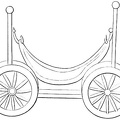Horse litters, carried between two horses, one in front and one behind, were used in early times by ladies of `rank`, by sick persons, and also on occasion to carry the dead. Similar vehicles of a lighter description, carried by men, were also in use.
William of Malmesbury states that the body of William Rufus was brought from the spot where he was killed in the New Forest in a horse-litter (a.d. 1100). When King John fell ill at Swineshead Abbey, in 1216, he was carried in a horse-litter to Newark, where he died. For a man who was in good health to travel in such a conveyance was considered unbecoming and effeminate. In recording the death, in 1254, of Earl Ferrers, from injuries received in an accident to his conveyance, Matthew Paris deems it necessary to explain that the Earl suffered from gout, which compelled him to use a litter when moving from place to place. The accident was caused by the carelessness of the driver of the horses, who upset the conveyance while crossing a bridge.
The illustration is copied from a drawing which occurs in a manuscript in the British Museum (Harl. 5256).
- Author
- Title: Early Carriages and Roads
Author: Walter Gilbey
Pulished in 1903
Available from gutenberg.org - Posted on
- Monday 25 October 2021
- Dimensions
- 825*545
- Tags
- Century:15th, Horse, Transport
- Albums
- Technology / Transport / Land / Horse Powered
- Visits
- 1328
- Downloads
- 42
 Download Photo
Download Photo





